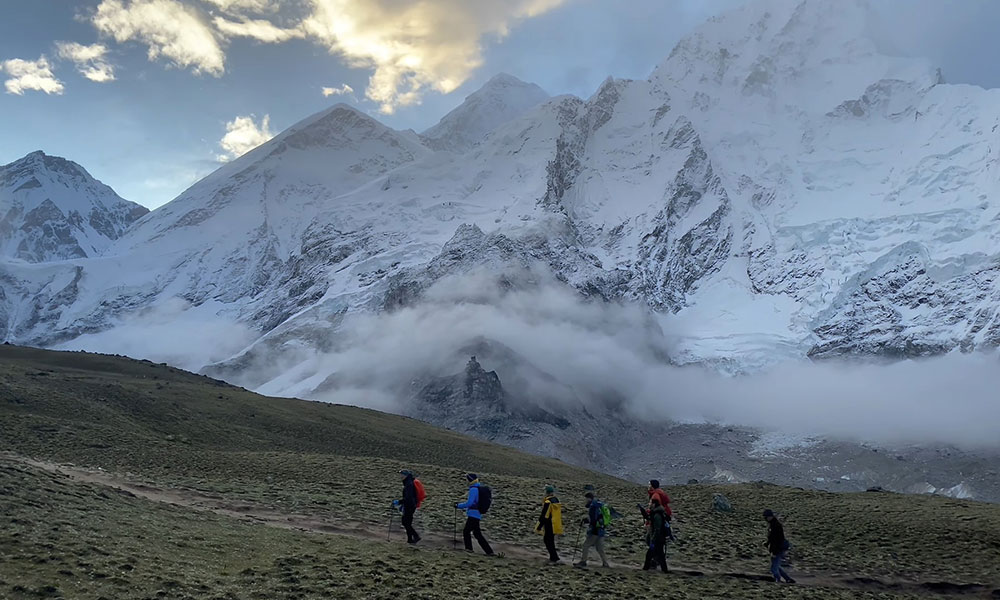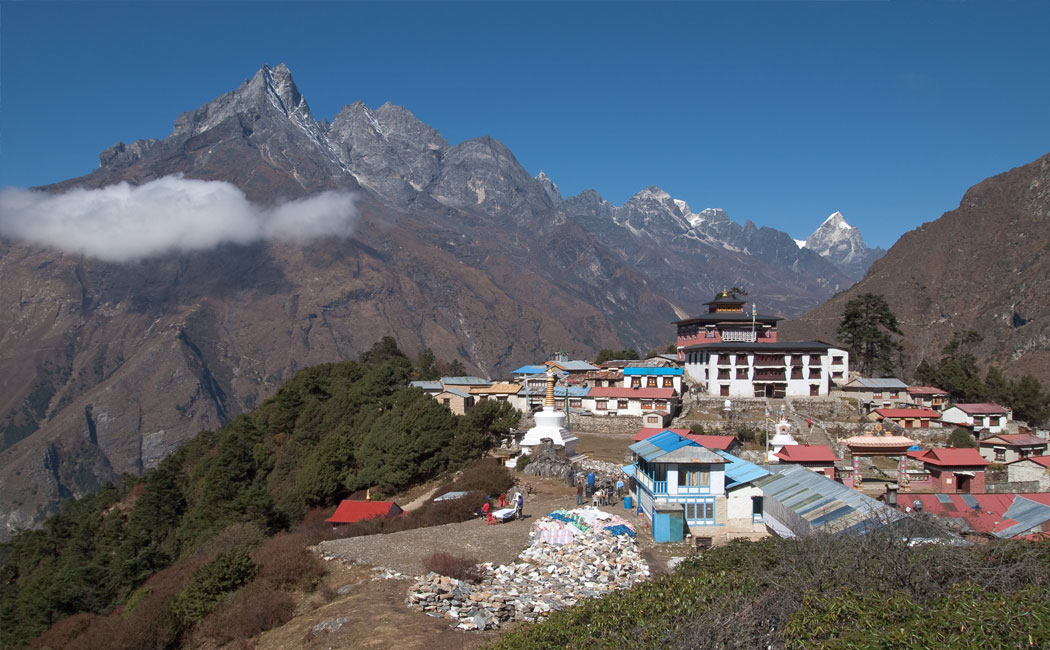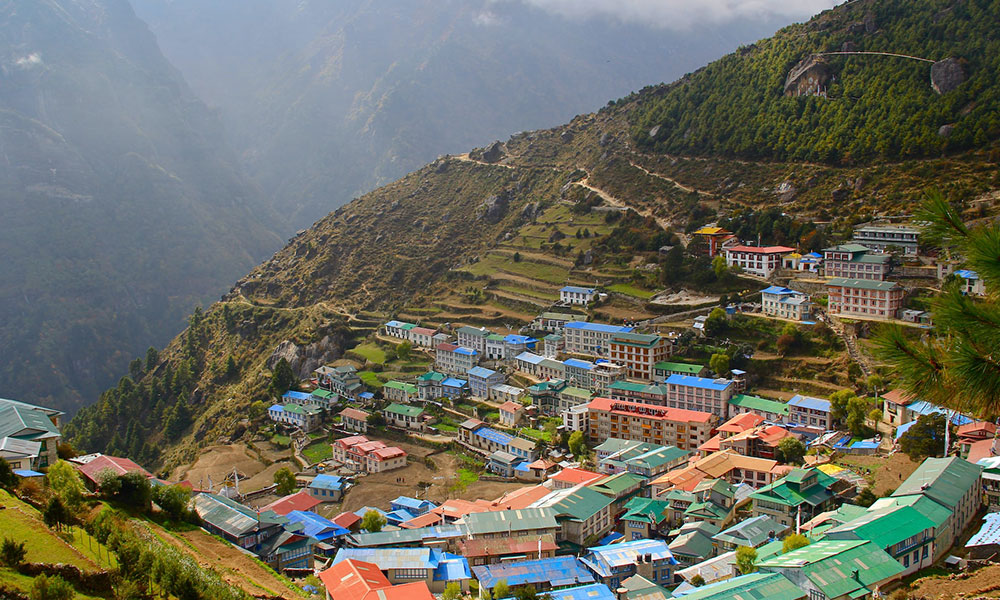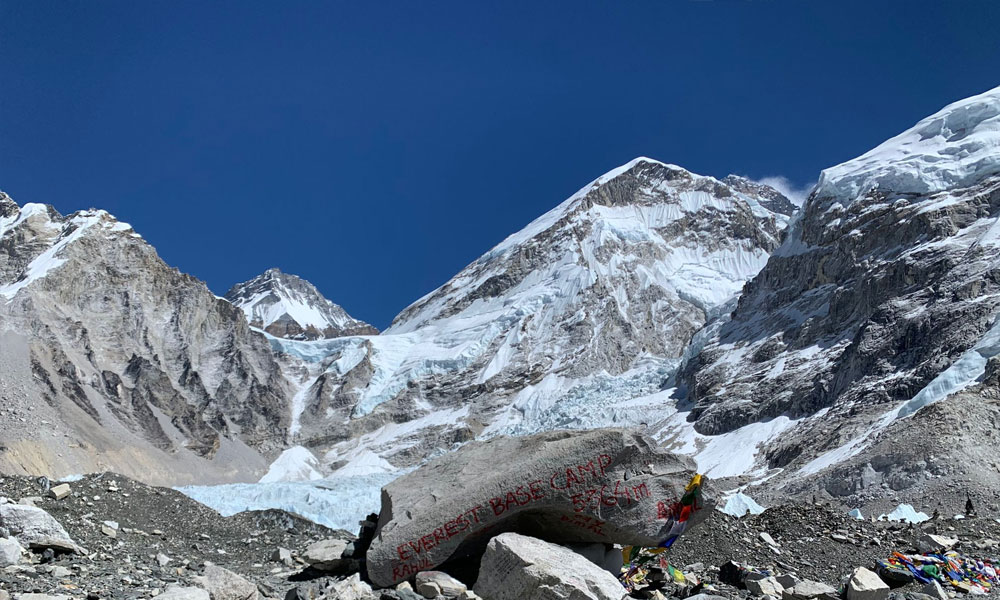Whether you’re looking for the toughest climb or just a week-long hike, the Everest region has pretty much all of it. Khumbu is home to some of the most heart-warming and eminent trek destinations that hikers bask in the glory of visiting.
While many of its trek spots have easy access, others are still out of reach, following rugged trails, uninhabited fields, and high altitudes. Nevertheless, the one that blazes with its classic trek route, geological wonders, and incredible scenery is Everest Base Camp.
Everest Base Camp is one of Nepal’s most iconic treks with breathtaking landscapes, glacial moraines, and mountainous hills. Much of its section is entrancing with gorgeous villages, friendly locales, and a picture-postcard backdrop.
With the Everest Base Camp elevation of 5,364 meters, the trek comes with a panoramic view of snowy mountains, defining landscapes, and glaciers. Visitors can witness the glaring Khumbu Icefall along with Mt. Everest, Cho Oyu, and Nuptse. For travelers planning the journey, understanding Everest Base Camp Elevation and FAQs ,including altitude, trek difficulty, best season, acclimatization, and fitness requirements ,helps ensure a safe and rewarding trekking experience.
Everest Base Camp elevation and altitude profile

Everest Base Camp is a center of attraction for trekkers backed by picturesque Lhotse and Thamserku. It’s a popular tourist draw following majestic sights, riveting country walks, and pretty villages. The base camp mostly serves visitors who relish nature and its fortifying charm.
Avid hiker fancies Everest Base Camp trek, given its unrivaled splendor and easy accessibility. However, walking the zigzagged trails to the Base Camp is never easy, particularly at a higher altitude.
Everest Base Camp is perched on the foot of Mt. Everest at an elevation of 17,598 ft above sea level, which causes the trek to be automatically tricky. Besides, the unforeseeable weather and craggy routes make things only worse.
Hence, hikers must be extremely wary while navigating the trail from Lobuche to Base Camp. The sections between these two are the most gruesome, with crushed rocks and steep hills. Starting from Lukla, the trail passes several villages, including the most celebrated Namche at 11,286 ft. and Dingboche at 14,468 ft.
Hikers of base camp frequently stop over the settlement to get food and drinks while climbing the base camp. They even use the tea houses and lodges in the villages for dwelling and to avoid the high winds. Setting up camps is common in Lobuche due to the small settlements with few houses.
Upon arriving at the base camp, trekkers will see lofty mountains, imposing landscapes, and Khumbu icefall. Besides the bad weather, visitors will catch as many mountain vistas as possible from the base camp, including Kangtega and Nuptse.
Mountaineers often use the base camp to acclimatize before going for Khumbu Glacier while heading to the summit. Most trekkers attempt to climb Kala Patthar beneath the south Pumori as it offers a mind-blowing vista.
Are you in doubt about whether to visit Everest Base Camp or not? Then, check the article “Is Everest Base Camp worth visiting?”
Day by Day Guide for Everest Base Camp Trek Elevation
Day 01: Flight to Lukla, Trek to Phakding

Max Elevation: 2,610 m
Walking Hours: 2-3 hrs
The Lukla flight is the perfect way to start the Everest Base Camp trip. Its short yet scenic escape from the city’s ruckus to over the glistening mountains and green hills is astounding. Just half an hour's flight from Kathmandu beyond the meandering and wild route for trekkers to end up at Lukla.
Lying at an elevation of 9,380 ft, Lukla is a pretty town in Khumbu, Pasanglhamu. It sits beside the mountain ridge, surrounded by rolling hills and mountainous terrain, providing a grand vista. Trekkers don’t spend much time at Lukla but head for the trail along the Dudh Koshi River.
It takes about 3 hours of steep walk from Lukla to arrive at the small village of Phakding. It’s the UNESCO world heritage site and homestead for many trekkers who’re on their way to Everest Base Camp. There are a bunch of lodges and guest houses in Phakding to provide dwellings to visitors.
Day 02: Trek to Namche Bazaar
Max Elevation: 3,440 m
Walking Hours: 5-6 hrs
Namche Bazaar is the latest hotspot for trekkers longing to get a snap of Mt. Everest in a little time. It’s a magnificently beautiful village with the naive charm of mountain ranges, terrace farms, and sweeping hills.
Namche is a gateway to Everest Base Camp and lies merely 8 miles away from Phakding at 3,440 meters high. Walking the village is more comfortable with marked trails, less steep hills, and a pristine view of snowy peaks.
It’s just a matter of a 5-6 hour walk from Phakding to Namche through the winding and narrow routes. Hikers can witness exotic wildlife and birds as the trail goes through Sagarmatha National Park.
The most famous Sherpa village across Khumbu, Namche, has many historical and cultural sites to explore. The town has many colorful markets, cheese factories, and primordial monasteries to scour. It even has a cultural museum restoring architectural excellence, traditional crafts, and rich history.
Day 03: Acclimatization day
Max Elevation: 3962 m
Walking Hours: 4-5 hrs
A port of entry to Everest, Namche is fancied by trekkers for altitude acclimatization. Most of them stop at the village and perhaps take a walk-through to tackle bitter weather at higher elevations. Many trekkers ascend Syangboche or take a stride of Hotel Everest View to pre-adjust to the weather and get a taste of the picturesque view.
A trip around the hilltop offers a spectacular view of dazzling Mt. Everest alongside Thamserku, Lhotse, and Ama Dablam. The quiet trail of Namche unveils a lovely alpine forest, primeval Chortens, and mani walls while walking downhill.
Day 04: Trek to Tengboche

Max Elevation: 3,856 m
Walking Hours: 6-7 hrs
With the otherworldly beauty of Ama Dablam and the emblematic Tibetan monastery, Tengboche no doubt stands from the rest of the village. It’s utterly stunning and homey, with a great atmosphere that can spellbind anyone.
Stretching 9.7 km long from Namche, Tengboche rests atop a hill beside Imja Khola and Dudh Koshi River’s conflux. The village walks a long-drawn path from Namche above the ground level and besides the mani walls.
Since the route to Tengboche is mostly uphill and rugged, it takes hikers slightly more time than usual. Some of them may even struggle a bit while going high due to the low air pressure. Whatsoever, the trip still gets them pumped up with a drop-dead view of Ama Dablam, windswept foothills, and prayer flags.
Overlooking the sky-scraping snow peaks, Tengboche is home to the most significant religious shrine. Visitors from far and wide deliberately visit or stop at the hamlet to offer prayers and take blessings. Visitors are allowed to participate in the Mani Rimdu festival hosted by the monks of Tengboche monastery.
They perform ritual dances, religious songs, and worship idols, which gives the excursionist a brief knowledge about the Sherpa culture. A lot of travelers who’re interested in nature opts to walk in the forest to discover wildlife. 
Day 05: Trek to Dingboche (4,380 m), 4-5 hrs
Max Elevation: 4,380m
Walking Hours: 4-5 hours
Tucked away in the northeast of Chukhung Valley, Dingboche is another rural settlement in Khumbu Valley. Unlike other places, it’s more rustic, with an impressive flat top at an altitude of 4,410 meters.
Trek to Dingboche starts with a gentle slope downward and across the river, which offers a stunning view. Hikers spend most of their time climbing uphill beside the river valley and stone walls to arrive at the village.
Dingboche, one of the most intriguing Everest Base Camp villages, is incredibly fantastic with hidden natural beauty. It’s vibrant and captivating, with friendly locals, magnetic sceneries, and secret landmarks.
The village is sparsely populated with a few tea houses run by local people. Trekkers have plenty of things to do here, including a short tour of Buddhist shrines and discerning unique flora and fauna.
Day 06: Rest day at Dingboche
Max Elevation: we do not gain height this day
Walking Hours: 2-3 hrs
In light of its inevitable charm and magnificence, trekkers find it impossible to leave Dingboche without spending a day. It’s probably why most hikers take a day off for a self-guided village tour.
Dingboche is known for its simplistic yet regal beauty with scintillating mountains, deep green forests, and stiff rock cliffs. Trekkers stop by the village to watch the glorious Imja Tse and Ama Dablam. They make the most of their stop at the small hamlet by catching a glimpse of the beautiful color palette of sunrise and the unspoiled beauty of Mt. Everest.
There’s a helipad on the west of the Imja River, which allows visitors to take a flight and reach the village in no time. Those who’re pressed for time take a private aircraft for the getaway to the deserted mountain.
Day 07: Trek to Lobuche

Max Elevation: 4,938 m
Walking Hours: 5-6 hrs
Crushing the lofty hills and steep slopes of Khumbu Valley to dwell at an altitude of 4,900 meters is quite bold of hikers. But, since it’s Lobuche and its sweeping mountainous view, the suffering is still worth it.
Trekking the settlement is arguably the coolest thing providing endless marvels and heart-warming views. Adding to the classic beauty of Lobuche are surrounding hills and gorges, which provide a scene to watch.
Other attraction includes wide-open meadows, beautiful Chortens, and steep rock faces. The trek to Lobuche from the outskirt of Dingboche takes 4-5 hrs of a precipitous climb on a rocky path. It tips over Pheriche Valley and to the alpine scrub, which provides mesmerizing scenery.
The trek carves its way from Thokla Pass, which is relatively more challenging due to loose rocks. Fortunately, there are lots of spectacular views and landscapes along the way that will keep hikers busy.
Day 08: Trek to Everest Base Camp (5,364 m), Hike to Gorakshep
Max Elevation: 5,364 m
Walking Hours: 6-7 hrs
Everest Base Camp is undoubtedly the highlight of the trek and also the most stressful one. It’s somewhat more challenging than others with harsh terrain, weaving through rocky moraines and frozen lakebeds.
Most of the trail makes its way on the sharp rocks and boulders, which is nerve-wracking. The weather shift is another obstacle for trekkers as the swirling wind storms and blizzards can entirely impede their trek.
The trek from Gorak Shep to Everest Base Camp is 2.5 miles and takes nearly 1-2 hours of sharp climb. It’s nestled on the toe of glistening snow peaks and glaciers over huge rocks. Since Everest Base Camp's elevation is 5,364 meters, visitors will easily catch a glimpse of Mt. Everest alongside Nuptse and Cho Oyu.
Once the sightseeing is done, climbers will return to the village of Gorak Shep, which is equally fabulous. Roosted on the brink of a frosty lake basin, Gorak Shep is idyllic. It’s a major attraction of Everest Base Camp with a staggering view of mountain landscapes, rock cliffs, and sparkling glacial lakes.
Day 09: Trek to Pheriche
Max Elevation: 4,371 m
Walking Hours: 5-6 hrs
With the sightseeing almost over, trekkers head their way back to the trail. Coming out of the village of Gorak Shep, they descend the lane to Pheriche through the debris and moraine of Khumbu Glacier.
Although the course to Pheriche is mostly downward sloping, the trek will still take 6-7 hours. Sitting at an elevation of 14,340 ft, Pheriche is an old-fashioned village with an irresistible backdrop of undulating hills and lush green forests.
Day 10: Trek back to Namche

Max Elevation: 3,440 m
Walking Hours: 6-7 hrs
Trek to Namche is more of a descent down the hill and crossing swift rivers and forests to the valley. The trail weaves its way through the remote villages of Monjo and Jorsale to arrive at the village. The journey to Namche from Lukla will take around 6-7 hours.
Day 11: Trek to Lukla
Max Elevation: 2,860 m
Walking Hours: 6-7 hrs
Unlike previous, the trek to Lukla from Namche is significantly more comfortable with downward slopes. The trails pass through many beautiful villages, cross the roaring rivers, and walk deep down the valley to reach Lukla at 2,860 meters.
Day 12: Flight to Kathmandu
Max Elevation: 1,440 m
Flight: 40 minutes F
On the last day of the hike, hikers take a flight back to Kathmandu from the Lukla airstrip. The trip will last for about 30-40 minutes, during which passengers will get to sight the cascading waterfalls, luscious hills, and endless mountain ranges.
How difficult is Everest Base Camp?

Climbing Everest Base Camp is undoubtedly easier than scrambling the mighty Everest. But if it’s put forth along with any other trek spots in Khumbu, the Everest Base Camp trek will still be terrifying with extreme altitude gain and long-stretched trails.
The craggy tracks running through the sheer ice sheets and exposed bedrocks are always formidable to ride. The difficulties don’t end up here as the hikers fight against low barometric pressure while going high.
Acute mountain sickness is the fear of every trekker climbing Everest Base Camp due to reduced air density. With each climb toward the base camp, trekkers will have difficulty breathing. Immediate exposure to high mountains causes headaches, dizziness, and insomnia.
It’s, therefore, trekkers of Everest Base Camp have to be careful while ascending the steep trail. Preventive measures must be taken in advance to avoid altitude sickness or get medical help. Adjusting to the base camp’s climate and temperature is the best way to prevent acute mountain sickness.
Hence, trekkers must acclimatize adequately given the Everest Base Camp elevation of 17,598 ft. Besides that, they have to be physically fit and mentally tough to beat the Base Camp’s uneven trail. If you're planning to make a trip to trek your way to the Everest Base Camp, then you should check out our professional trek packages specially our Short Everest Base Camp Trek package that we recommend the most from which we too will guide and provide you with all the necessities required for the journey!
You may also like:
- 10 Best Everest Base Camp Trek Packages
- Is Everest Base Camp Worth Visiting?
- Everest Base Camp Trek in September
Everest Base Camp FAQs

1. How high is Everest Base Camp?
Sitting on the foot of the world’s tallest mountain, Everest Base Camp is majestic and dwells at an elevation of 5,364 meters. It’s the most alluring trek spot with the lovely setting, unspoiled mountain spectacles, and rock face.
Climbing the base camp is a daunting task with never-ending inclined trails that walks through rocky moraine dunes and existing sediment rocks. Hikers are recommended to be extremely careful while scaling up the crags.
2. Do we have to prepare for Everest Base Camp?
Preparation for Everest Base Camp is a must for trekkers, especially beginners who have no past experience. They should assess their fitness level and consequently develop plans to increase endurance and flexibility.
Since the paths are grueling, trekkers will have to stay in good shape. They have to fully indulge in strict fitness training and diet to strengthen physical stamina and improve balance. Climbers should analyze the difficulty level of the trek and train accordingly.
Generally, aerobic workouts like brisk walking, swimming, and jogging help prepare for Everest Base Camp Trek. The simplest exercise, like cycling and stair climbing, also fosters health and reduces the risk of altitude sickness.
Check out the blog on ‘Training Tips for Everest Base camp. ‘
3. How is the accommodation at high altitudes?
Accommodations in Everest Base Camp are super diverse. From lodges to hotels and guest houses, there are enough options for trekkers. However, the choices for accommodation get fewer after climbing high altitudes.
Due to the highly exposed region, there’s little to find in the upper hills except for a few tea houses and homestays. The service standard available in tea houses is acceptable, but they’re not so great.
They have basic facilities with a single bedroom, bedsheet, blanket, and pillow. Meanwhile, the cost of these tea houses is reasonable, making the deal pretty fair. Trekkers can also buy their dinner and breakfast in the tea houses.
4. How long does it take to climb the base camp?
The Everest Base Camp trek usually lasts about two weeks or less, depending on the itinerary. Most travel companies offer a trip of 10-14 days, making the trip less stressful and easy. If the hikers extend their trip length to explore the village, it shall take more than two weeks.
5. How difficult is fighting against Everest Base Camp elevation in winter?
With a long-distance trail of 38.58 miles from Lukla, the Everest Base Camp hike is naturally challenging. The paths to base camp are steep and usually layered in snow, making it impossible to get a grip.
But the weather at an elevation of 5,364 meters makes the base camp trek a lot harder and nerve-wracking. Heavy snowfall and storms make Hiking the camp incredibly challenging in winter.
The harsh weather can bring the trek to a halt or leave the trekkers stranded on the trail. It’s why visitors are cautioned about the weather or suggested to read the weather forecast before climbing high.
6. What challenges does Everest Base Camp elevation bring?
The trek is quite stressful since Everest Base Camp climbs the trail up to 5,364 meters. Hikers will have to walk the endless trail that winds up and down. Not just that, they even have to batter harsh weather conditions of the base camp as it lies high above sea level.
Temperatures in winter drop up to -7 Degrees Celsius and even lower, causing the visitor to freeze. Due to the increasing altitude of the Base Camp, trekkers are even prone to suffer from severe headaches and fatigue.
7. Do we suffer from altitude sickness while climbing Everest Base Camp?
Trekkers are more likely to suffer from acute mountain sickness while climbing the base camp due to the high altitude. Breathing becomes hard in and around the campsite due to low atmospheric pressure. Most trekkers only have mild symptoms like insomnia, fatigue, dizziness, and high blood pressure.
But, if the illness is not taken care of on time or continuously ignored, it may get serious. Therefore, trekkers suffering from altitude sickness must get help on time. Besides, they shouldn’t continue hiking and get the needed rest.
8. Is it possible to take a flight to Everest Base Camp?
Of course, travelers can hire a private aircraft to fly over the base camp and enjoy the mesmeric views. It helps you easily avoid Everest Base Camp’s elevation gain and clasp your eyes on Mt. Everest. Before landing at Kala Patthar, the flight takes off from Kathmandu and flies over Himalayan villages, including Namche and Gorak Shar.

